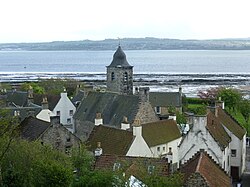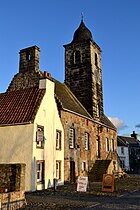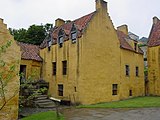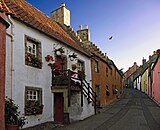Culross
| Culross | |
| Fife | |
|---|---|
 Culross and the Firth of Forth | |
| Location | |
| Grid reference: | NS985859 |
| Location: | 56°3’19"N, 3°37’45"W |
| Data | |
| Population: | 395 |
| Postcode: | KY12 |
| Local Government | |
| Council: | Fife |
| Parliamentary constituency: |
Dunfermline & West Fife |
The town of Culross is a village and royal burgh on the coast of Fife. It was once an important port, monastic centre and palace town, but it has declined so that a population estimate in 2006 gave the village a population of just 395. The decline however is only in greatness and population; it remains a jewel of a place, its ancient buildings forming one of the prettiest places on the coast of the Forth.
Culross is believed to have been founded by Saint Serf during the 6th century.
Contents
Founding legend
A legend states that when the British princess Teneu, daughter of the king of Lothian, fell pregnant before marriage, her family threw her from a cliff. She survived the fall unharmed, and was soon met by an unmanned boat. She knew she had no home to go to, so she got into the boat; it sailed her across the Firth of Forth to land at Culross where she was cared for by Saint Serf. Serf became the foster-father of her son, Saint Kentigern or Mungo (d. 612).
Industry
During the 16th and 17th centuries, the town was a centre of the coal mining industry. Sir George Bruce of Carnock, who built the splendid 'Palace' of Culross and whose elaborate family monument stands in the north transept of the Abbey church, established at Culross, the first coal mine in the world to extend under the sea, in 1575. The mine worked what is now known as the Upper Hirst coal seam, with ingenious contrivances to drain the constant leakage from above. This mine was considered one of the marvels of the British Isles in the early 17th century, until it was destroyed in a storm, in 1625.[1]
Culross' secondary industry was salt panning. There was a considerable export trade by sea in the produce of these industries and the prevalence of red roof tiles in Culross and other villages in Fife is thought to be a direct result of collier ships returning to Culross with Dutch roof tiles as ballast. The town was also known for its monopoly on the manufacture of 'girdles', (iron griddles for baking).[2] The town's role as a port declined from the 18th century, and by Victorian times it had become an almost deserted place. The harbour was filled in and the sea cut off by the coastal railway line in the second half of the 19th century, though the site of the harbour walls can to a large extent still be traced.
Heritage
During the 20th century, it became recognised that Culross contained many unique historical buildings and the National Trust for Scotland has been working on their preservation and restoration since the 1930s.
Notable buildings in the burgh include Culross Town House, formerly used as a courthouse and prison, the 16th century Culross Palace, 17th century Study, and the remains of the Cistercian house of Culross Abbey, founded 1217. The tower, transepts and choir of the Abbey Church remain in use as the parish church, while the ruined claustral buildings are cared for by Historic Scotland.
Many of the buildings in the Royal Burgh of Culross are now in the care of the National Trust for Scotland.
Just outside the town is the 18th-century Dunimarle Castle, built by the Erskine family to supersede a mediæval castle.
Thomas Cochrane, 10th Earl of Dundonald spent much of his early life in Culross, where his family had an estate. There is now a bust in his honour outside the Culross Town House. He was the first Vice Admiral of Chile.
Culross as a location for filming
Several film have used Culross as a picturesque location for filming, including:
- The Little Vampire (2000 feature film),[3]
- The 39 Steps[4]
- Kidnapped
- A Dying Breed[5]
- Captain America: The First Avenger
Outside links
| ("Wikimedia Commons" has material about Culross) |
- Culross community site
- Culross Arts and Music Festival
- Culross on FifeDirect
- Royal Borough of Culross – National Trust for Scotland
- Culross - A Topographical Dictionary of Scotland (1846)
References
- ↑ "Culross". Undiscovered Scotland. 2002-2009. http://www.undiscoveredscotland.co.uk/culross/culross/index.html. Retrieved 8 Sep 2009.
- ↑ Hearth and Home - Fife Folk Museum]
- ↑ http://www.scotlandthemovie.com/movies/vampcul.html
- ↑ http://www.imdb.com/title/tt1282016/locations
- ↑ http://www.imdb.com/title/tt1058522/


